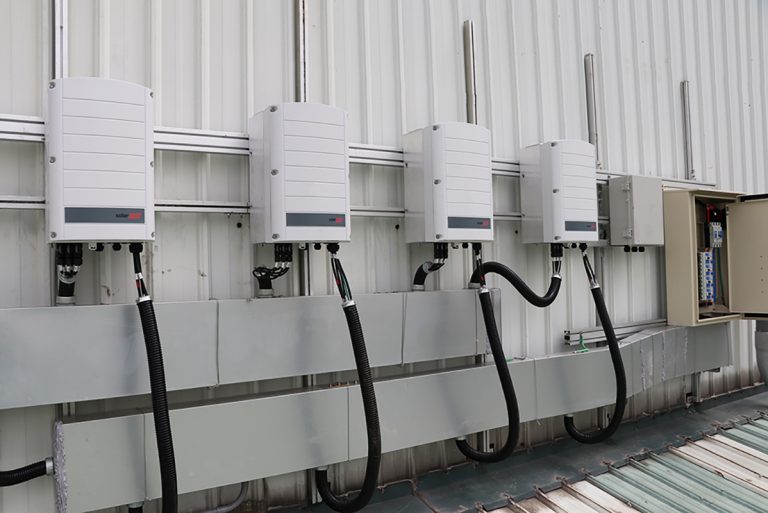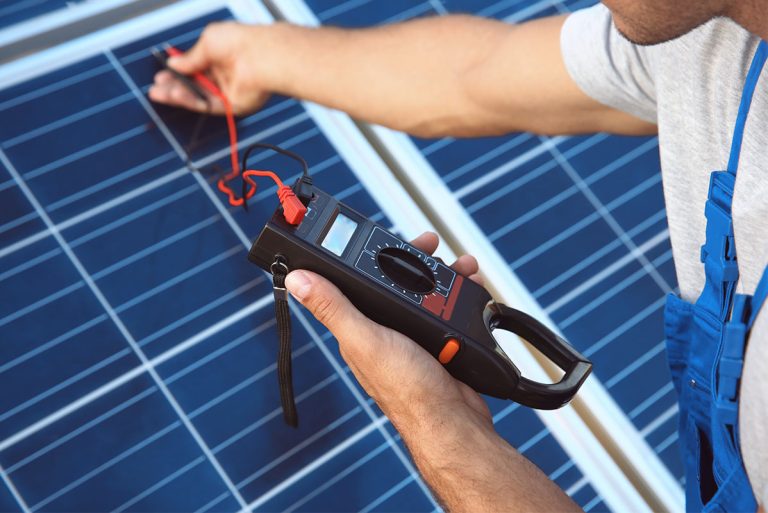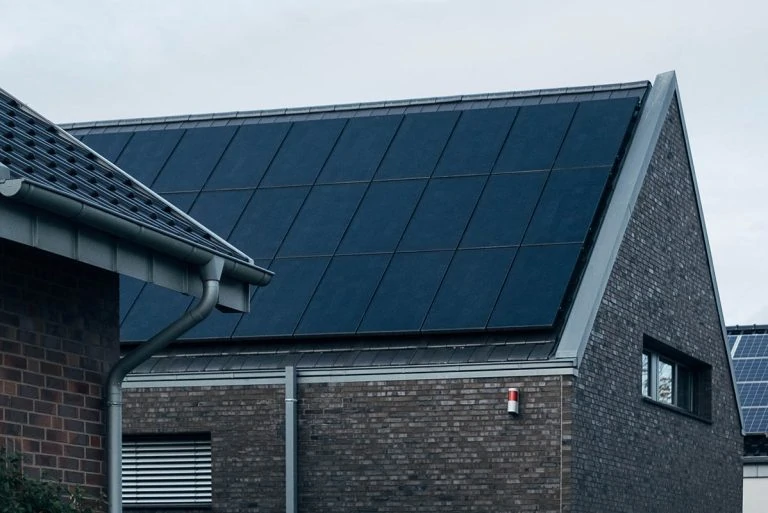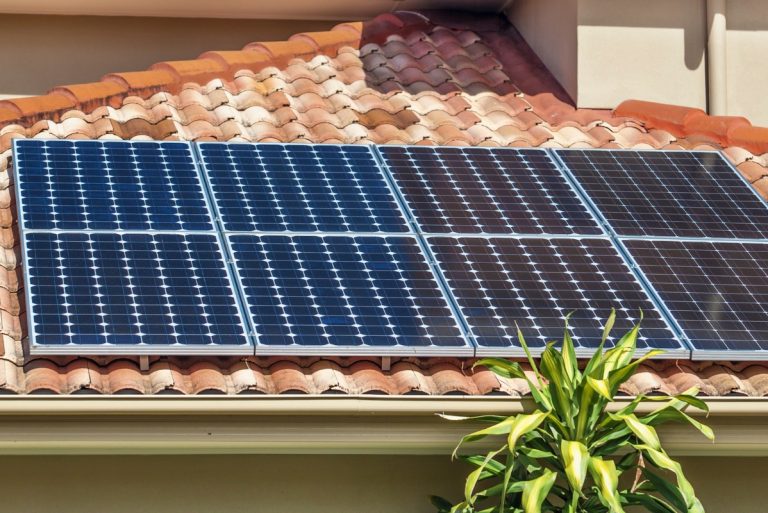If you’re building a solar system, you’ll need an excellent solar charge controller to protect your battery and keep your system safe and performing well. Our top pick for the best solar charge controllers is the Renogy Voyager PWM Waterproof Solar Charge Controller, but we’d also recommend the Victron Energy SmartSolar MPPT 30 Amp Solar Charge Controller for larger and more complex systems.
- Works with different types of batteries
- Excellent battery protection
- Waterproof
- Need to set lithium parameters manually
6 best solar charge controllers for all kinds of systems
The right solar charge controller for you will depend on a wide range of factors, including the capacity of your solar array and the type of battery you have. Here are our top picks for systems of all kinds and sizes.
1. Renogy Voyager PWM Waterproof Solar Charge Controller
This waterproof charge controller is suitable for 12-volt off-grid applications such as cabins, boats, and RVs and offers five-stage PWM charging: soft-start, bulk, absorption, float, and equalization.
This charge controller is compatible with various types of batteries: sealed/AGM, gel, flooded and lithium batteries. This makes it much more versatile than many other PWM charge controllers, which is great if you already have a battery for your system.
The Renogy Voyager will protect your battery in a number of ways, including reverse polarity and battery connection, reverse current, over-temperature, and over-voltage protection. It also has a blue backlit LCD that displays system information and error codes, making it easy to manage your system and troubleshoot issues.
A key selling point of this PWM charge controller is that it is completely waterproof, so is ideal for boats and outdoor environments. It comes with a IP67 waterproof rating and will continue to perform optimally even when exposed to rain, spray, or condensation.
What we like:
- Versatile for use with multiple batteries: You can use this charge controller with a range of different types of batteries, so can be used for different kinds of systems.
- Excellent battery protection: It offers reverse polarity and battery connection, reverse current, over-temperature, and over-voltage protection, extending the life of your battery and meaning you’ll save money but not having to replace your battery so often.
- Waterproof: The charge controller is rated IP67 waterproof, so is perfect for boats and outdoor use.
What we don’t like:
- Need to set lithium parameters: Although this charge controller is compatible with lithium batteries, you’ll need to set the system voltage and appropriate parameters manually, which may be intimidating for beginners.
This IP67 waterproof charge controller is ideal for outdoor use, or anywhere that your system may experience spray or condensation.
2. Mohoo 30A PWM Solar Charge Controller With Dual USB Port
This PWM solar charge controller from Mohoo performs all the essential functions you need from this type of device at the fraction of the price of many of its competitors.
The charge controller will protect your battery against reverse discharge, as well as over and under voltage protection with its intelligent PWM charging mode. It’s easy to set-up and features a large LCD screen for system control and monitoring as well as dual built-in 12V/24V USB ports.
You can choose between three types of charge control: direct charge, boost charge, floating charge. Other features include a timer setting, light control, and 12V/24V automatic identification.
However, this charge controller does have certain limitations. It’s only compatible with certain lead-acid batteries, so you can’t use it with other types of storage like lithium or nickel-metal hydride batteries.
Additionally, it’s only designed to receive current from solar PV panels, so you can’t connect your system to DC power. This could be an issue for RVs and campers that want to be able to switch between solar and DC electricity depending on where they’re parked.
What we like:
- Affordable: This charge controller comes with a very affordable price tag, so is perfect for those on a budget.
- Dual USB port: With two built-in USB ports, you can charge your devices directly on the charge controller, which is great for more compact systems, like boats, RVs, and camping.
- User-friendly: The intuitive LCD display makes this charger controller easy to set up and use, so is great for those with little experience with solar systems.
What we don’t like:
- Limited applications: You can only use this charge controller with lead-acid batteries, and it’s only designed for solar PV systems, not DC electricity.
Although not the most complex or features-rich solar charge controller on the market, this no-frills device from Mohoo offers adequate protection to small solar systems at a very affordable price.
3. Outback Power Flexmax 80 MPPT Solar Charge Controller
This charge controller has an impressive voltage capacity of 150V so is perfect for large, off-grid systems. It can handle inputs up to 5000 Watts and currents up to 80 Amps, thanks to its intelligent thermal management feature.
This advanced MPPT charge controller can increase your solar system’s power output by up to 30% in all conditions, even on cloudy days and in low light, with a range of features like intelligent thermal management cooling. The versatile device is compatible with most types of lead-acid and lithium-ion batteries and can charge batteries between 12V and 60V.
You can remotely program and monitor the charge controller using a MATE system display, which provides complete system integration. You’ll also be able to see data logs from the past 128 days on the controller’s built-in display, allowing you to track your system to optimize performance and identify issues.
However, all of these features and high voltage capacity come with a high price tag, and this is by far the most expensive product on this list.
What we like:
- Highly efficient: This charge controller will boost your system output by up to 30%, helping you to reduce or eliminate your reliance on the grid, and slash your power bills.
- Large capacity: With a voltage capacity of 150V and being capable of handling 5000 Watts, this device is suitable for very large solar arrays.
- Remote monitoring: This controller’s MATE system display allows you to monitor your system remotely, so you can ensure everything is performing optimally.
What we don’t like:
- It’s expensive: This charge controller involves a significant upfront investment, so may not be worth it unless you have a large solar system and need its advanced features.
If you’re building a large, off-grid system and need a reliable, versatile charge controller with a high voltage capacity, the Outback Flexmax 80 could well be worth the investment.
4. Victron Energy SmartSolar MPPT 30 Amp Solar Charge Controller
Victron is well-known for their quality, high-performing solar controllers with excellent tracking and monitoring systems. This 30 Amp charge controller has automatic battery voltage recognition, a flexible charge algorithm and temperature compensation to protect your batteries from overcharging or overheating.
It also offers ultra-fast maximum power point tracking as well as advanced maximum power point detection, helping the system to quickly adjust and maintain maximum output in partial shading. The versatile controller is compatible with gel, flooded, AGM, lithium-ion and LiFePO4 batteries.
Victron’s SmartSolar controllers have built-in Bluetooth that allows you to connect the device to their impressive Remote Management Portal. Using the portal, you can set up, update and monitor your system remotely, as well as get detailed historical info on your power output and usage.
However, the controller doesn’t have any kind of display screen, only three indicator lights to show the current status, so you’ll need to use the app to manage the device.
What we like:
- Remote monitoring app: Victron’s SmartSolar app is renowned for its usability and detailed reporting data, allowing you to track your system performance and get the most out of your solar panels.
- Compatible with different kinds of batteries: You can use this controller with a variety of different types of batteries, including lithium-ion batteries.
- Customizable: Victron allows you to customize a wide variety of settings, so you can adjust this to meet your needs or for a custom battery.
What we don’t like:
- No display screen: The charge controller doesn’t have any kind of display screen, so you’ll need to do everything through the app.
The Victron SmartSolar 30 Amp charge controller is an efficient, reliable solution with excellent monitoring functions. It’s an excellent option for all mid-size solar systems, but especially self-contained setups like RVs and campers.
Victron also offers 20-Amp and 50-Amp models with very similar features and functions.
5. EPEVER 40A MPPT Solar Charge Controller
One of the most affordable MPPT charge controllers on the market, this high-quality product boasts an impressive tracking efficiency of 99.5% and a peak conversion efficiency of 98%. Designed to optimize battery life and improve the overall system performance, it will protect your battery against reverse polarity, overcharging, over-discharging, overload, short-circuiting and reverse current.
It also offers four-stage charging, temperature compensation, automatic 12V/24V system voltage identification and multiple load work modes.
The charge controller is compatible with various deep cycle battery types, including sealed, gel, flooded, and lithium batteries, and has a real-time energy statistics function that helps you monitor your system and quickly address any issues.
One thing that makes this charge controller stand out is its ultra-fast tracking speed thanks to the device’s advanced MPPT control algorithm. This means that it quickly adapts when different parts of your panels receive more or less light, minimizing power loss time due to shading.
On the downside, some online reviewers complain that it is not very user-friendly and, in particular, that it’s difficult to program, with poor instructions.
What we like:
- Value for money: As one of the cheapest MPPT charge controllers available, this quality product offers excellent value for money.
- Fast tracking speed: With advanced, fast tracking, the charger quickly adapts to low light conditions, so can give you extra power when moving in and out of shading.
- Versatile: This charge controller will work with sealed, gel, flooded, and lithium batteries, giving you the freedom to choose virtually any kind of battery.
What we don’t like:
- Not user-friendly: With some users complaining that the charge controller is challenging to set up and program, this may not be the best choice for beginners.
You may need to do some groundwork to get this charge controller setup, especially if you don’t have a lot of experience with solar systems. However, overall this is a highly-efficient, reliable charge MPPT controller that offers excellent value for money and will help you to maximize your system output.
6. Renogy Rover MPPT 20 Amp Solar Charge Controller
Renogy Rover series of MPPT charge controllers offer highly efficient charging for 12V and 24V off-grid solar systems. This solar charge controller uses powerful smart tracking technology to maximize your battery’s charging process, along with multiple battery, controller, and solar protections.
Its advanced MPPT technology offers up to 99% high tracking efficiency and 96% conversion efficiency. Features include 12V/24V automatic system recognition, lithium-reawakening, as well as overcharging, over-discharging, reverse polarity, overload, and over-temperature protection.
The controller also has a backlit LCD display that shows system information and error codes, with four deep cycle battery presets: gel, flooded, lithium-ion phosphate (12.8V), and sealed/AGM.
The set includes the Rover 20 A MPPT charge controller and a temperature sensor, which will help to protect your equipment and avoid damaging your battery.
However, some reviewers have expressed concern that the controller is not very robust. In particular, they complain about the tiny, flimsy input terminals that could be prone to breaking if you don’t handle them with care.
What we like:
- Temperature sensor: The kit comes with a temperature sensor which will prevent your battery from overheating, protecting your equipment and keeping you safe.
- Highly efficient: Like other quality MPPT charge controllers, this product offers extremely-high tracking and conversion efficiency, allowing you to get the maximum amount of power from your solar system.
- Affordable: The controller has a range of advanced features while being relatively inexpensive for an MPPT controller.
What we don’t like:
- Small input terminals: The charge controller’s input terminals are pretty small and not very robust, so could break if not handled carefully.
Although it may not have the most robust construction, this MPPT charge controller offers an impressive range of advanced features for a reasonable price. This efficient, features-packed MPPT charge controller and temperature sensor will allow you to get the most out of your system and protect your battery, particularly from overheating.
Buying guide: what you should know about solar charge controllers
If you’re building a solar system, you’re probably mostly focused on what type of solar panels and battery you should buy. However, don’t overlook the importance of a charge controller: this humble device plays a critical role in any solar set up.
Solar charge controllers are essential for regulating and managing your battery charging process, helping to protect your equipment and keep your system (and you) safe.

Why you need a solar charge controller
Unless you’re using a simple, portable solar panel to charge your cell phone directly, or a ready-made solar trickle charger, your solar system will need some kind of battery.
A battery allows you to store the sun’s energy for later, so that you can use it when there’s not much light, such as on cloudy days or overnight. This is especially important if you’re fully relying on solar power, such as in off-grid systems, boats, or RVs.
A charge controller is an essential piece of equipment that regulates the flow of energy between your solar panel and its battery.
The key functions of a charge controller are to:
- Prevent battery overcharge: The controller makes sure your battery doesn’t receive too much current, minimizing safety risks, protecting your equipment, and extending battery life.
- Low voltage disconnect: You can set some controllers to automatically turn off the system when the battery falls to a certain voltage, to prevent over-discharge.
- Block reverse currents: Controllers prevent current from flowing back to the solar panels when it’s dark, which could drain your battery.
In essence, a charge controller makes sure that your battery doesn’t receive too much current, and that it doesn’t lose too much charge. Let’s take a closer look at why it’s important not to overcharge your battery.
Why you need to avoid overcharging your battery
Overcharging your battery doesn’t mean overfilling it, but rather giving it too much current. Charge in this sense refers to the amount of current that is sent to the battery.
This is because batteries operate through chemical reactions that reverse their negative and positive charges. When we send an electrical current to a battery, this reverses the electrical state, or charge, that the battery obtains when it is discharged.
When we talk about overcharging, it’s not like charging your cell phone battery, but rather introducing too much current, or electricity, to the battery.
Given that 12-volt batteries can handle a maximum voltage of 14.4 volts and you can expect the current from your solar panel to be 20 volts upwards, which is multiplied if you have more than one panel, the current needs to be regulated between the solar panel and the battery.
Even if you have a 12-volt solar panel, this doesn’t mean you can connect it directly to a 12-volt battery. Most solar panels put out much more power than their nominal voltage, around 19 volts in standard test conditions of 25 degrees Celsius (77 degrees F) and the voltage output increases the colder it gets.
As you can probably imagine, sending too much electricity to a battery can have a range of adverse effects, from causing the battery to get too warm, to making it melt or even explode. Therefore, a charge controller is an essential part of your solar system that not only helps to ensure everything performs well, but also protects your equipment and your safety.
How solar charge controllers work
Most modern charge controllers work by allowing current to flow through the battery in different stages, depending on the charge level.
Four-stage charge controllers are one of the most common systems, with these four stages:
- Bulk: When the battery is empty, the controller will charge the batteries with full current.
- Absorption: As the battery charges and reaches a certain voltage, the controller slows the current down to safe levels.
- Float: Once the battery is full, it receives only a trickle charge at low voltage to keep the battery topped up without overheating.
- Equalization: Only used on flooded batteries, this process involves periodic high voltage charge boosts to “shake-up” the electrolytes in the battery, smooth the voltage of the cells and complete the relevant chemical reactions.
Things to consider when buying a charge controller
There is a huge range of solar charge controllers available, with a large number of different specifications and features. Solar charge controllers can also vary greatly in price, so it can be difficult to know which product is right for you.
Here are some key things in mind to find the right solar charge controller for your system.
1. The type of solar charge controller
The first thing you’ll notice when shopping for solar charge controllers is that there are two main types: PWM and MPPT controllers. So what is the difference exactly?
Pulse Width Modulated (PWM) solar charge controllers
PWM charge controllers work by gradually reducing the current flow as the battery nears a full state. Once the battery is fully-charged, the controller maintains a “trickle” state, supplying a small and constant amount of power to keep the battery at maximum voltage.
PWM solar charge controllers work with the same current voltage flowing in both directions, so the nominal voltage of your battery bank must match that of your solar panel system.

These types of charge controllers are generally much more affordable than MPPT charge controllers, but also typically have a much lower voltage capacity. For most PWMs, you’ll be limited to a maximum of 400 watts for your entire solar array, so are only suitable for smaller solar systems.
Additionally, not all PWM controllers have a temperature sensor, so you will need to buy one separately or risk damaging your equipment.
Maximum Power Point Tracking (MPPT) solar charge controllers
MPPT charge controllers are more sophisticated than PWMs, but they also involve a significantly higher upfront investment. This type of controller works by adjusting their input to extract the maximum amount of power from your solar system, and they can also vary their output to match that of the battery.
MPPT controllers protect your battery like a PWM, and will also reduce the inflow to your battery bank as it comes close to capacity. They can work with panels and batteries with different voltages, are up to 30% more efficient than PWM controllers, and are generally compatible with a range of different types of batteries.

This type of charge controller is recommended for larger solar arrays, as they may not be cost-effective for homes and RVs with lower solar power needs. Having said that, they offer better conversion rates, especially in cloudy conditions and cold winter climates.
Furthermore, for larger systems with lots of wiring, using a MPPT controller can help you save on wire costs, allowing you to set up a series connection rather than a parallel connection that uses thinner wires.
2. Maximum voltage and current
Another important aspect to check is the controller’s capacity, which tells you how much voltage and current it can handle. Solar charge controller’s maximum voltage can range from 12V up to 150V for the most powerful devices.
Equally, maximum input ranges from as low as 8A for RV charge controllers to 80A for high capacity models.
To determine the capacity of charge controller you need, you’ll need to do a few calculations that consider not only the capacity of your solar panels and how many panels you have, but also other influencing factors, such as the temperatures your panels will be exposed to.
It’s important to work this out pretty accurately, as you need a controller that can handle the amount of current in your system in order to make use of all of the power produced by your panels. Equally, you don’t want to overestimate the voltage and Amps you need, as the price is usually proportional to the controller’s capacity.
The video below breaks down how you can calculate what size controller you need.
3. Battery compatibility
Most controllers can be connected to 12V or 24V batteries, but some are only suitable for 12V batteries. Other, more powerful charge controllers, can charge batteries of up to 60V.
Additionally, some charge controllers are only compatible with certain types of batteries, so it’s important to check this also. Most PWMs are only compatible with lead-acid batteries, such as gel, sealed and flooded batteries. MPPTs can typically work with all of these battery types as well as the lithium variety.
Finally, depending on your needs, you may need to check how easy it is to program the controller with a custom profile. If you’re building a custom battery, you’re best going for a charge controller that you can program to meet your needs like the Victron Energy SmartSolar MPPT 30 Amp Solar Charge Controller.
4. Load control
Solar charge controllers can shut down system output automatically if the battery charge gets too low. This prevents extreme discharging, which can permanently and severely damage your battery.
If you want to be able to turn the load off at any time, look for a charge controller with manual load control. Investing in a solar charge controller with a load controller could save you tons of money in the long run, as you won’t need to invest in a pricey new battery.
5. Temperature compensation
This function ensures that the controller will reduce the voltage if the battery temperature gets too hot. This feature involves an external temperature sensor that may come with the controller, or you may need to buy separately.

Source: Renogy
A temperature sensor is an essential feature to protect your equipment and avoid damaging your battery and shortening its life. It’s standard with most MPPT charge controllers, such as the EPEVER 40A MPPT Solar Charge Controller or Renogy Rover MPPT 20 Amp Solar Charge Controller.
Although a charge controller with temperature compensation may involve a higher upfront investment, this will also save you money in the long run as you won’t need to buy a new battery as often.
6. System monitoring and control
Finally, one of the key features to look for in a charge controller is whether you can monitor and control your solar system. Many charge controllers allow you to check the status of your battery, how much power is produced by the panel and other key performance data.
Most solar charge controllers have a simple LCD display that shows you basic info. Some, like Victron Energy SmartSolar MPPT 30 Amp Solar Charge Controller, can connect to an app on your smartphone via Bluetooth for more detailed info and better systems control.
Final thoughts
A solar charge controller is an essential part of any solar system, protecting your battery, and helping to make sure you get the most out of your solar panels.
If you need a fairly simple charge controller for a smaller solar system, take a look at a PWM controller like the Renogy Voyager PWM Waterproof Solar Charge Controller. If you’re looking for a more advanced controller for a medium to large set up, consider the Victron Energy SmartSolar MPPT 30 Amp Solar Charge Controller, or for a really large solar array, we’d recommend the Outback Power Flexmax 80 MPPT Solar Charge Controller.
Whatever product you go for, just be sure to consider the capacity you need, the battery you’re going to use, features like temperature compensation, and system monitoring.
If you’ve enjoyed this roundup of the best solar charge controllers, take a look at our guides to the best flexible solar panels and how to test a solar panel.



















